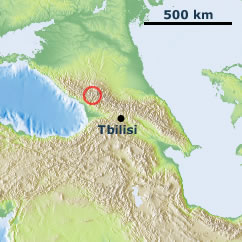 |
|
|
|
|
|
|
One of the world's biodiversity hotspots, the giant Caucasus is often considered the border between Europe and Asia, but it is also a phytogeographic bridge between the subcontinents. With Kasbek and Elbrus exceeding 5000 m, the alpine land area is very large. Birch and pine are common treeline species. Land use plays an important role, with most of the alpine grassland grazed regularly by large herds of sheep. The examples shown here are from Georgia and the Elbrus region. |
|
1 - Kazbek (5047 m), and alpine pasture land at 2000 m in the foreground. |
|
|
2 - Pockets of Betula litwinowii (Betulaceae) and steep slopes with Sesleria sp. (Poaceae) grassland at 2500 m near Kazbegi. |
3 - Carex tristis (Cyperaceae) at 2900 m, the dominant alpine sedge, corresponding to Carex curvula (Cyperaceae) in the Alps or Kobresia sp. in the Rocky Mts. |
|
4 - Traditional shepherded alpine grazing near Kazbegi (Georgia, 1800-2200 m). |
5 - Traditional alpine grazing creates a terrassed, stable, short grass sward. |
|
6 - Elbrus (5643 m) |
|
|
7 - Nival flora at 3500 m: Tephroseris (=Senecio) karyaginii (Asteraceae). |
8 - Veronica minuta (Scrophulariaceae) |
9 - Tripleurospermum subnivale (Asteraceae) |
29 August 2011 |
||
| |
||










